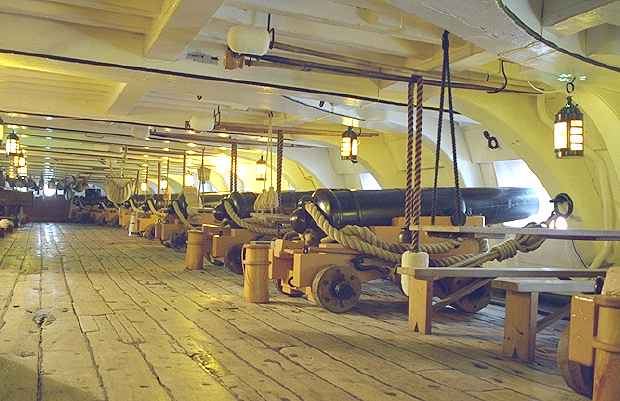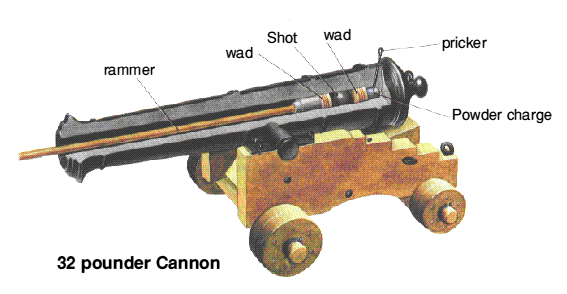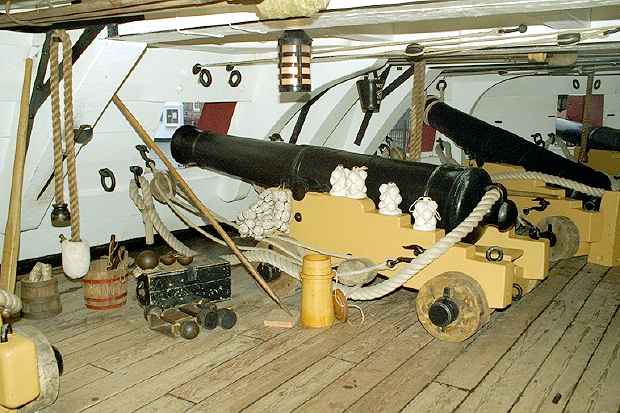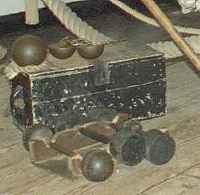DAS ORIGINAL: H.M.S. VICTORY
GUNDECKS

HMS Victory - the lower gundeck
HMS Victory was a First Rate Ship of the Line - mounting 104 guns on 3 gun decks.
The upper gun deck has 12 pdr cannon, the middle gun deck 24 pdr guns and the massive 32 pdr cannon are mounted on the lower gun deck.

The 32 pounder cannon weighs 3.5 tonnes - 2.75 tonnes for the gun barrel and 0.75 tonnes for the wooden gun carriage. It fired a 32 pound (14.7Kg) ball, usually propelled by an 11 pound (5Kg) gunpowder charge giving a muzzle velocity of 1600 feet per second (487 metres per second). Fired from the lower gun deck, with the muzzles some 2m above the waterline, this gave a point blank (fired flat) range of approximately 1000 feet (300m).
The Royal Navy trained hard and well - and could reload the guns in 90 seconds. This was a quite remarkable time - given the considerable amount of manhandling required to move the 3.5 tonne gun backwards and forwards - and far shorter than that achieved by French or Spanish crews. It is little wonder that the most common injury to gun crews was abdominal rupture.

When the gun was fired it recoiled inboard, restrained by the large ropes attached to the rear of the gun barrel. A sponge was dipped in water and thrust down the barrel to remove any traces of burning powder. The new charge and wad were then inserted into the barrel and rammed hard against the rear of the gun. The wad held the charge in place and ensured that the powder was tightly compressed. Next, the rammer was removed and the ball inserted, held into place by a further wad rammed hard down the barrel. A pricker was inserted into the breech hole to open the gunpowder charge and then a small quantity of fine powder poured down the firing hole and into the flintlock pan. The flint lock was cocked and the gun was ready to fire.
The gun was served by a six man crew - known by numbers to make orders easier in the noise of battle. Number 1 was the Gun Captain who aimed and fired the gun. Number 2 used a long spike to turn and raise the barrel; Number 3 loaded the gun and rammed the shot and powder home. Number 4 sponged out the gun, ensuring that no burning powder or waste was left to cause premature ignition of the new charge. Number 5 worked opposite 2 to move the gun whilst Number 6 was the smallest and youngest member of the crew - the powder monkey. Often young boys, perhaps only 10 or 12 years old, the powder monkey collected the gunpowder charges from the magazine deep in the hold of the ship and carried it to the gun.
The whole 3.5 tonnes was now run out, with the crew straining on the carriage ropes to pull the gun muzzle through the gun port in the side of the ship. When the gun came to bear on the target, the gun captain pulled the lanyard to the flint lock. As the flint scraped across the pan a shower of sparks ignited the fine powder - which ignited the main charge and the gun fired, ejecting its iron ball with a forward velocity of some 500 metres per second. The gun would recoil backwards at some 2 metres per second, and the process of cleaning and reloading began again.

32pdr gun and equipment: ball, chain, bar and grape shot, rammers, sponges etc.
The gun could be loaded with a variety of shot - from the plain cannon ball to bar shot, chain shot and grape shot. Bar and Chain shot whirled around in flight and was intended to cut through enemy rigging, bringing down masts, sails and spars and disabling the ship. Grape shot was an anti-personnel weapon, firing a quantity of smaller balls in a cluster. These spread out and created a murderous hail of metal across an enemy deck. The 32 pound cannon ball was effective in punching holes through the wooden walls of the enemy - creating a huge spray of deadly flying splinters. At close range, the 32 pound ball was capable of penetrating wood to a depth of 2½ feet.
With the enemy holed and disabled and the crew killed or wounded with grape shot, the attacking ship could now close the enemy and board the vessel to secure victory. Boarding with close quarters hand to hand fighting was often the deciding factor in battle.
Chain and bar shot 
Grape shot 






 Impressum Datenschutz
Impressum Datenschutz








